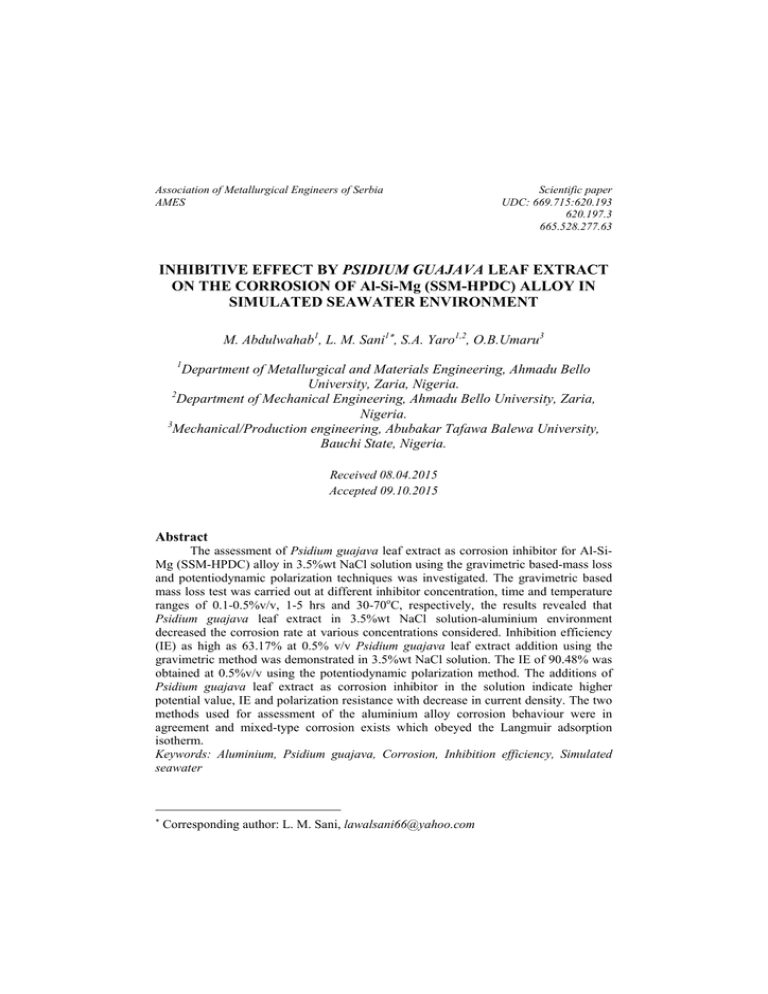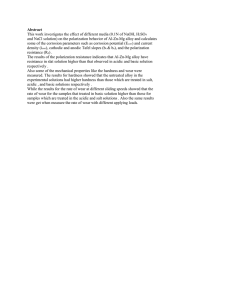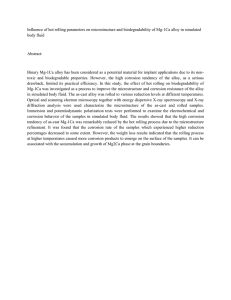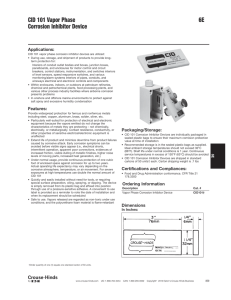INHIBITIVE EFFECT BY PSIDIUM GUAJAVA LEAF EXTRACT ON
advertisement

Association of Metallurgical Engineers of Serbia AMES Scientific paper UDC: 669.715:620.193 620.197.3 665.528.277.63 INHIBITIVE EFFECT BY PSIDIUM GUAJAVA LEAF EXTRACT ON THE CORROSION OF Al-Si-Mg (SSM-HPDC) ALLOY IN SIMULATED SEAWATER ENVIRONMENT M. Abdulwahab1, L. M. Sani1, S.A. Yaro1,2, O.B.Umaru3 1 Department of Metallurgical and Materials Engineering, Ahmadu Bello University, Zaria, Nigeria. 2 Department of Mechanical Engineering, Ahmadu Bello University, Zaria, Nigeria. 3 Mechanical/Production engineering, Abubakar Tafawa Balewa University, Bauchi State, Nigeria. Received 08.04.2015 Accepted 09.10.2015 Abstract The assessment of Psidium guajava leaf extract as corrosion inhibitor for Al-SiMg (SSM-HPDC) alloy in 3.5%wt NaCl solution using the gravimetric based-mass loss and potentiodynamic polarization techniques was investigated. The gravimetric based mass loss test was carried out at different inhibitor concentration, time and temperature ranges of 0.1-0.5%v/v, 1-5 hrs and 30-70oC, respectively, the results revealed that Psidium guajava leaf extract in 3.5%wt NaCl solution-aluminium environment decreased the corrosion rate at various concentrations considered. Inhibition efficiency (IE) as high as 63.17% at 0.5% v/v Psidium guajava leaf extract addition using the gravimetric method was demonstrated in 3.5%wt NaCl solution. The IE of 90.48% was obtained at 0.5%v/v using the potentiodynamic polarization method. The additions of Psidium guajava leaf extract as corrosion inhibitor in the solution indicate higher potential value, IE and polarization resistance with decrease in current density. The two methods used for assessment of the aluminium alloy corrosion behaviour were in agreement and mixed-type corrosion exists which obeyed the Langmuir adsorption isotherm. Keywords: Aluminium, Psidium guajava, Corrosion, Inhibition efficiency, Simulated seawater Corresponding author: L. M. Sani, lawalsani66@yahoo.com 242 Metall. Mater. Eng. Vol 21 (4) 2015 p. 241-251 Introduction Aluminium and its alloys find application in many industries due to high strength to weight ratio, good corrosion resistance, excellent workability, high electrical and thermal conductivity. However, the ability of aluminium and its alloy to resist attack in aggressive corrosive environment have been reported to be poor [5]. The use of inhibitors for corrosion control of materials, which are in contact with aggressive environment, is an accepted practice [9]. Although synthetic inhibitors when used for corrosion control have been reported to indicate an excellent performance, majority of these inhibitors are not eco-friendly and are expensive [8]. Therefore, effort towards identifying any potential eco-friendly and less expensive corrosion inhibitors remains relevant and important. The growing interest among researchers for green inhibitors remained a top research focus. In this direction, plant extracts and oil have gained acceptance as corrosion inhibitors that are considered safe, eco -friendly, available and less expensive for most metals and alloys [8]. Accordingly, the present study focus on the use of Psidium guajava leaf extracts as corrosion inhibitors for high pressure die cast (SSM-HPDC) Al-Si-Mg alloy. Experimental Work Materials and sample preparation Aluminium alloy specimens of dimension 12 12 2 mm with chemical composition as shown in Table 1 were used as coupons for the corrosion study in Psidium guajava- 3.5%wt NaCl solution. Table 1. Chemical composition of aluminium alloy Element Al Si Mg Fe Cu Mn Zn Ti Sr wt.% 92.28 7.14 0.36 0.10 0.01 0.01 0.01 0.07 0.02 Initially, the coupons were mechanically polished with emery papers down to 800 grit size, the specimens were degreased in ethanol, dried, weighed and stored in desiccators. The initial weight of each sample was taken and recorded. Gravimetric measurement The corrosion rate by gravimetric analysis was carried out on the previous weighed samples with and without inhibitor at 30, 50 and 70 oC. The volume of the solution was 150ml with and without the addition of Psidium guajava inhibitor. The Psidium guajava inhibitor concentration was varied from 0.1, 0.2, 0.3, 0.5%v/v in 150ml of 3.5%wt NaCl solution. For each sample, using gravimetric method, the samples were washed, dried and weighed at interval of 1, 2, 3, 4 and 5 hrs of exposure time. The corrosion rates and inhibition efficiencies were calculated. Potentiodynamic polarization technique The potentiodynamic polarization and linear polarization resistance was used to characterize the corrosion rate of aluminium in Psidium guajava-simulated seawater medium. In the electrochemical test, a glass corrosion cell kit with a platinum counter electrode, a saturated Ag/Ag reference electrode and aluminium specimens as working Abdulwahab at al. - Inhibitive effect by Psidium guajava leaf extract on the corrosion … 243 electrode were used. The working electrode specimens were positioned at the glass corrosion cell kit, leaving 1.14cm2 surfaces in contact with the solution. Polarization test was carried out in simulated seawater solution at room temperature using a potentiostat. The polarization curves were determined by stepping the potential at a scan rate of 0.003V/sec. The polarization curves were plotted using Autolab data acquisition system and both the corrosion rate and potential were estimated by the Tafel extrapolation method. Results Figures 1-3 represent the variation of corrosion rates with immersion time at different concentration of extract. The variation in percentage inhibition efficiency (% IE) with concentration of inhibitor (%v/v) is shown in Figure 4-7. Table 2 indicates the potentiodynamic polarization data obtained for Al-Si-Mg (SSM-HPDC)-3.5wt% NaCl/ Psidium guajava environment. Figure 8 shows the linear polarization curves for Al-SiMg (SSM-HPDC) -3.5wt% NaCl/ Psidium guajava environment. Figure 9 shows the comparative chart of inhibition efficiency using different methods of corrosion evaluation. Figure 10 represents the Langmuir isotherm for the adsorption of Psidium guajava leaf extract on Al-Si-Mg (SSM-HPDC) alloy. Discussion Gravimetric-based mass loss measurement Effect of inhibitor concentration and time on corrosion rate From results, the corrosion rate (Figures 1-3) showed the variation of corrosion rate of the alloy in simulated seawater environment decreased with addition of inhibitor. In Figure 1, the sample in NaCl/0.5%v/v Psidium guajava leaf extract exhibit an excellent corrosion resistance. Similar trend was observed in Figures 2 and 3. For example, corrosion rate decreased from 11.54x102 mpy (control) to 4.25x102 mpy (0.5%v/v) at 30oC for 1hr immersion time (Figure 1). While at 50oC/70oC (0.5%v/v) for 1hr immersion time, corrosion rate decreased from 16.28x102 /18.79x102 mpy (control) to 9.11x102 / 13.67x102 mpy. The significant decrease in corrosion rate at 0.5%v/v inhibitor concentration can be attributed to the adsorption of inhibitor molecules on alloy surface which act as physical barrier to restrict the diffusion of ions to and from the alloy surface and prevent the alloy atoms (ions) from precipitating in further anodic or cathodic reactions, hence resulting in decrease in corrosion rate [3]. 244 Metall. Mater. Eng. Vol 21 (4) 2015 p. 241-251 14 Corrosion Rate (mpy x102) 12 10 0.0%v/v 8 0.1%v/v 6 0.2%v/v 4 0.3%v/v 2 0.5%v/v 0 1hr 2hrs 3hrs 4hrs 5hrs Time of exposure (hrs) Fig. 1. Variation of corrosion rate of Al-Si-Mg (SSM-HPDC) alloy with time of exposure in the presence of guava (Psidium guajava) leaf extract at 30oC. 18 Corrosion rate(mpyx102) 16 14 12 0.0%v/v 10 0.1%v/v 8 0.2%v/v 6 0.3%v/v 4 0.5%v/v 2 0 1hr 2hrs 3hrs 4hrs 5hrs Time of exposure (hrs) Fig. 2. Variation of corrosion rate of Al-Si-Mg (SSM-HPDC) alloy with time of exposure in the presence of guava (Psidium guajava) leaf extract at 50oC. Corrosion rate (mpyx102) Abdulwahab at al. - Inhibitive effect by Psidium guajava leaf extract on the corrosion … 245 20 15 0.0%v/v 0.1%v/v 10 0.2%v/v 5 0.3%v/v 0.5%v/v 0 1hr 2hrs 3hrs 4hrs 5hrs Time of exposure (hrs) Fig. 3. Variation of corrosion rate of Al-Si-Mg (SSM-HPDC) alloy with time of exposure in the presence of guava (Psidium guajava) leaf extract at 70oC. Effect of inhibitor concentration and time on inhibitor efficiency. Figures 4-6 showed the variations of inhibitor efficiency with time for guava leaf extract with values at maximum inhibitor efficiencies of 63.17, 61.71, 61.69, 61.67 and 28.41% with time of 1-5hrs respectively were obtained at concentration of 0.5%v/v at 30oC. This may be attributed to the fact that, as the extract addition increases, the surface area covered by the inhibitor increased hence higher IE was achieved [8]. 70 Inhibitor efficiency (%) 60 50 40 0.1%v/v 30 0.2%v/v 0.3%v/v 20 0.5%v/v 10 0 1hr 2hrs 3hrs 4hrs 5hrs Time of exposure (hours) Fig. 4. Variation of inhibitor efficiency of guava (Psidium guajava) leaf extract on Al-Si-Mg (SSM-HPDC) alloy with time of exposure at 30oC. 246 Metall. Mater. Eng. Vol 21 (4) 2015 p. 241-251 70 Inhibitor efficiency (%) 60 50 40 0.1%v/v 30 0.2%v/v 0.3%v/v 20 0.5%v/v 10 0 1hr 2hrs 3hrs 4hrs 5hrs Time of exposure (hrs) Fig. 5. Variation of inhibitor efficiency of guava (Psidium guajava) leaf extract on asreceived Al-Si-Mg (SSM-HPDC) alloy with time of exposure at 50oC. 40 Ihibitor efficiency (%) 35 30 25 0.1%v/v 20 0.2%v/v 15 0.3%v/v 10 0.5%v/v 5 0 1hr 2hrs 3hrs 4hrs 5hrs Time of exposure (hrs) Fig. 6. Variation of inhibitor efficiency of guava (Psidium guajava) leaf extract on as-received Al-Si-Mg (SSM-HPDC) alloy with time of exposure at 70oC. Abdulwahab at al. - Inhibitive effect by Psidium guajava leaf extract on the corrosion … 247 Effect of temperature on inhibitor efficiency It is evident from Figure 7 that inhibition efficiency decreases with increasing temperature. The decrease in inhibitor efficiency with increase in temperature can be attributed to the fact that at a lower temperature the inhibitor molecules are adsorbed onto the alloy surface, while at higher temperature increased rate of dissolution process takes place along with partial desorption of inhibitor molecules from the alloy surface as a result of dissociation of constituents of inhibiting substance [2, 7]. 70 Inhibition efficiency (%) 60 50 40 30 C 30 50 C 20 70 C 10 0 0,1 0,2 0,3 0,5 Inhibitor concentration (%v/v) Fig. 7. Variation of inhibition efficiency on Al-Si-Mg (SSM-HPDC) alloy with concentration of guava (Psidium guajava) leaf extract for immersion time of 1hr at different operating temperatures. Potentiodynamic polarization The results of potentiodynamic polarization experiments with Al-Si-Mg (SSMHPDC) alloy as working electrode in 3.5%wt NaCl/ Psidium guajava at 30oC at different concentrations of inhibitor are shown in Figure 8. It can be seen from Figure 8 that the inhibitor addition reduces both the cathodic hydrogen evolution and anodic metal dissolution reactions [6]. Thus, Psidium guajava extracts can be said to exhibit mixed-type corrosion because of the simultaneous change in the anodic and cathodic region during the electrochemical evaluation of the corrosion condition. The corrosion current (jcorr) values calculated by linear extrapolation of the Tafel plots are shown in Table 2. 248 Metall. Mater. Eng. Vol 21 (4) 2015 p. 241-251 Fig. 8. Potentiodynamic polarization curves for as-received Al-Si-Mg (SSM-HPDC) alloy in 3.5wt%NaCl at 30oC in absence and presence of different concentrations of Guava (Psidium guajava) leaf extracts. In the potentiodynamic polarization for Al-Si-Mg (SSM-HPDC) alloy in 3.5%wt NaCl/ Psidium guajava environment (Table 2), different measurement consisting of potentiodynamic polarization-corrosion rate (PP-CR), potentiodynamic polarizationcorrosion density (PP-Jcorr), and linear polarization resistance (LPR) were used as a criteria for evaluation of corrosion resistance of Al-Si-Mg alloy in the environment. Generally, the studied environment demonstrated a decreased corrosion rate and corrosion current density with addition of Psidium guajava inhibitor, while the corrosion potential (Ecorr) and polarization resistance (Rp) increase with inhibitor concentrations. In Table 2, the corrosion potential of the alloy in blank solution was 1.3069 V but at various concentration of guava leaf extract, the corrosion potential values are shifted towards the anodic side (-1.3006 V, -1.2663 V, -1.3033 V, -0.6180 V) indicating that the extract affects the anodic reaction predominantly. This is in agreement with previous reports [1, 7]. The inhibited Al-Si-Mg (SSM-HPDC) alloy in 3.5%wt NaCl showed that corrosion rate decreased from 0.95536 mm/yr to 0.44955, 0.25269, 0.83804 and 0.097876 mm/yr at 0.1, 0.2, 0.3, and 0.5%v/v Psidium guajava. A drop in jcorr value, corrosion rate and polarization resistance were observed when the concentration was increased from 0.2%v/v to 0.3%v/v. The drop at the higher inhibitor concentrations could be due to desorption of molecules from metal surface [6]. The linear polarization values showed that addition of guava leaf extract resulted in an increase in polarization resistance value (Rp) for the as-received alloy from 118.51Ω (uninhibited) to 1244.7Ω (inhibited) condition with an IE of 90.48%. The increase in Rp and corresponding decrease in jcorr generally suggested an improvement in corrosion resistance of the alloy in the presence of inhibitor. This shows that the alloy was protected within the immersion time considered [8]. Abdulwahab at al. - Inhibitive effect by Psidium guajava leaf extract on the corrosion … 249 Table 2. The potentiodynamic polarization parameters for the corrosion of Al-Si-Mg (SSM-HPDC) in 3.5wt% NaCl in the absence and presence of different concentration of guava leaf extracts. S/N Conc. (%v/v) Ecorr, obs(v) jcorr (A/cm2) 1 2 3 4 5 0.0 0.1 0.2 0.3 0.5 -1.3069 -1.3006 -1.2663 -1.3033 -0.6180 8.22E-05 3.87E-05 2.17E-05 7.21E-05 8.42E-06 Corrosion rate (mm/yr) 0.95536 0.44955 0.25269 0.83804 0.097876 Polarization resistance (Ω) 118.51 496.15 776.27 101.82 1244.7 IE (%) Inhibitor efficiency and adsorption behaviour The computed inhibitor efficiency (% IE) of age-hardened Al-Si-Mg (SSMHPDC) alloy-Psidium guajava in 3.5%wt NaCl solution was done using the equation reported [1, 8]. The variation in % IE using the gravimetric (G. M), potentiodynamic polarization-corrosion rate (PP-CR), potentiodynamic polarization-corrosion density (PP-jcorr), and linear polarization resistance (LPR) are presented in Figure 9 for 3.5wt%NaCl/ Psidium guajava. The results show that addition of Psidium guajava increased the IE with an increase in the inhibitor concentrations. This may be attributed to the fact that, as the Psidium guajava addition increases, the surface covered by this inhibitor increased hence higher IE was achieved. However, a decrease in IE from 0.2%v/v to 0.3%v/v was observed for the potentiodynamic polarization corrosion measurement. This could be due to desorption of molecules from the metal surface during the potentiodynamic polarization measurement. 100 90 80 70 60 50 40 30 20 10 0 G.M PP‐Jcorr PP‐CR LPR 0,1 0,2 0,3 0,5 C (% v/v) Fig. 9. Comparative chart of inhibitor efficiency (IE) for Al-Si-Mg-3.5%wt NaCl solution/Psidium guajava concentration obtained by gravimetric (G.M), potentiodynamic polarization-corrosion rate (PP-CR), potentiodynamic polarization-corrosion current (PP-Jcorr) and linear polarization resistance (LPR) 250 Metall. Mater. Eng. Vol 21 (4) 2015 p. 241-251 The adsorption mechanism of Psidium guajava leaf extract showed that the relationship between ⁄ and is linear for both in simulated seawater environment using different techniques of corrosion evaluation (Figure 10). Since the linear regression coefficient/or correction factors (R2) close to unity: G.M (0.767), PP-Jcorr (0.881), PP-CR (0.882), LPR (0.851), the adsorption behavior is assumed to have obeyed Langmuir adsorption isotherms. In this case, the adsorption of inhibitor molecules belongs to a monolayer adsorption, assuming that the lateral interactions between the inhibitor molecules are ignored. y = 0.809x + 0.259 R² = 0.767 (G.M) y = 0.832x + 0.498 R² = 0.881 (PP‐Jcorr) y = 0.832x + 0.498 R² = 0.882 (PP‐CR) y = 0.320x + 0.752 R² = 0.851 (LPR) 1 0,9 0,8 0,7 C/Ө 0,6 0,5 G.M PP‐Jcorr 0,4 PP‐CR 0,3 LPR 0,2 Linear (G.M) Linear (PP‐ Jcorr) 0,1 0 0 0,2 0,4 0,6 C (%v/v) Fig. 10. Langmuir isotherm for the adsorption of guava (Psidium guajava) leaf extract on Al-Si-Mg (SSM-HPDC) alloy obtained by gravimetric based-mass loss and potentiodynamic polarization method. Conclusions 1. Psidium guajava have been demonstrated to be an effective corrosion inhibitor for Al-Si-Mg (SSM-HPDC) alloy in 3.5wt% NaCl. 2. The corrosion resistance and inhibitor efficiency of Al-Si-Mg (SSM-HPDC) alloy increased with addition of Psidium guajava as inhibitor. IE as high as 63.17% and 90.48% in 3.5wt% NaCl- Psidium guajava condition was obtained for the gravimetric and potentiodynamic po-larization techniques respectively. 3. The adsorption behavior of Psidium guajava in 3.5wt% NaCl for Al-Si-Mg (SSM-HPDC) alloy may be regarded to obey the Langmuir adsorption isotherms. 4. Potentiodynamic polarization measurements show that Psidium guajava is a mixed type inhibitor predominant to the anodic branches. Abdulwahab at al. - Inhibitive effect by Psidium guajava leaf extract on the corrosion … 251 References [1] M. Abdulwahab, A.P.I. Popoola, O.S.I. Fayomi, Int. J. Electr. Sci. 7 (2012) 11706- 11717. [2] F. Asuke, S.A. Yaro, O.B. Oloche, V.S. Aigbodion, J. Met. Mat. Eng., 4 (2) (2009): 48-54. [3] F.A. Ayeni, I.A. Madugu, P. Sukop, A.P. Ihom, O.O. Alabi, R. Okara, M Abdulwahab, J. Min. Mat. Character. Eng. 11 (2012) 667-670. [4] A. Hossain, and A.S. Kurny, Int. J. Chem. Nucl. Metall. Mat. Eng., 8 (4) (2014) 288-293. [5] R.A. Mohammed, M. Abdulwahab, I.A. Madugu, J.O. Gaminana, F. Asuke, J. Mater.Environ. Sci. 4 (1) (2013) 93-98. [6] S.N. Victoria, R. Prasad, R. Manivannan, Electrochem Sci., 10 (2015) 2220-2238. [7] S.J. Olusegun, B.A. Adeiza, K.I. Ikeke, M.O. Bodunrin, J. of Emerging Trends Eng. Appl. Sci., (JETEAS) 4 (1) (2013)138-143. [8] A.P.I. Popoola, O.S.I. Fayomi, M. Abdulwahab, J. Electrochem. Sci., 7 (2012) 5817-5827. [9] G.Y. Stephen, O.A. Sylvester, G.T Tersoo, Int. J. Adv. Res. Chem. Sci., (IJARCS). 1 (2014) 38-46. [10] B.O. Umaru, Msc. Thesis, Ahmadu Bello University, Zaria, Nigeria. 2013, pp. 6, 9, 22.




